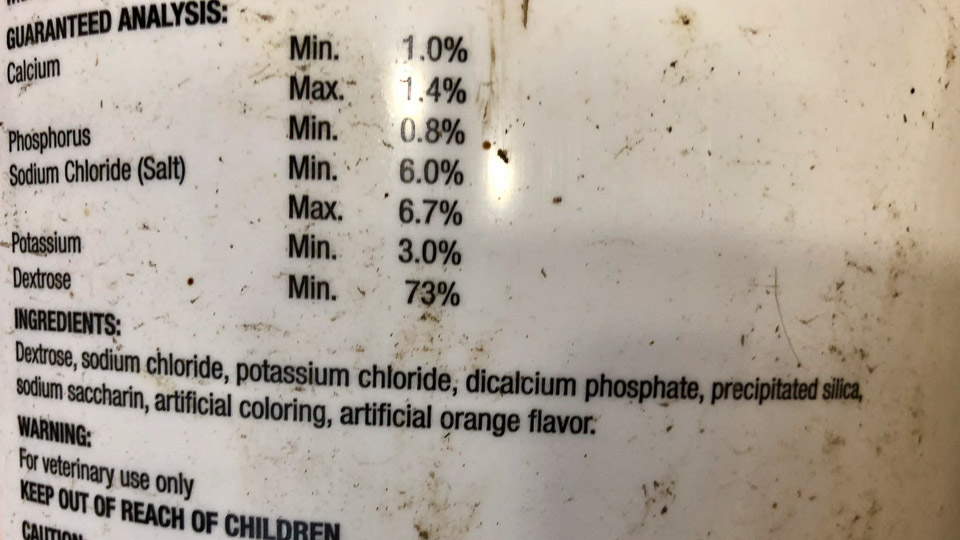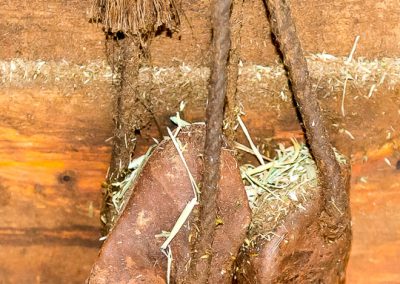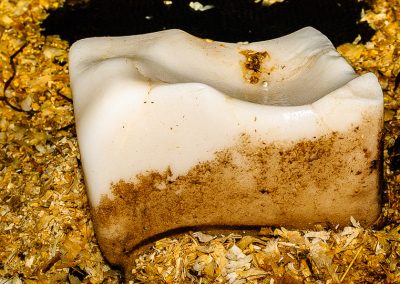
Horse Nutrition – Minerals And Electrolytes
The most common source of minerals is groundwater and the foods grown on the ground. Soils that are over produced usually yield poor crops so most hay is grown in supplemented soil (fertilized) including minerals. However many horse owners neglect their pastures and do not test and resupply the pastures with the needed minerals for healthy growth and continuous mineral supply for their horses.
Most horse owners also supply a source of salt. The common salt lick is made of sodium and chloride which are essential for life. Some add other minerals into a “sweet lick” or “red salt lick” which contain other minerals but also contain molasses and high fructose corn syrup. The best salt source is one that is mined from a salt deposit such as Himalayan salt because these have an assortment of macro and micro minerals.
A mineral is an atom or element with a nucleus of protons and neutrons surrounded by spinning electrons. Remember basic chemistry? You might remember that an atom can gain or lose electrons. When a mineral gains or loses an electron then the mineral becomes an electrolyte. Here is an example. Sodium (Na) can lose an electron and become a positively charged atom called Na+. Chloride can gain an electron and become a negatively charged atom called Cl-. These charged atoms (also known as ions) become attracted to each other because of their opposite charge and become an electrically balanced molecule called NaCl – what we call salt.
We are constantly losing minerals as electrolytes in our urine and our sweat. Through a very highly regulated process called chelation, horses absorb the minerals back into their body in the exact amounts they need. They will not absorb too much of any mineral and in fact, once the needed level is found they try not to lose any of it. An example of this is iron where most of the iron is found in the red blood cell within a protein called hemoglobin. The only way they lose this iron is through blood loss so very little iron is ever absorbed unless needed.
Adding an electrolyte source for almost all horses is unnecessary. Most of the supplemental electrolytes have sugar added (see the ingredient list in the image at the top) as we see in our sports drinks to aid absorption. It is necessary to add electrolytes when the horse is working hard, usually in the heat with exercise, causing excessive sweating. A condition called “thumps” or synchronous diaphragmatic flutter occurs where the horse “hiccups” or sharply inhales with every beat of the heart. Adding electrolytes by intravenous injection resolves this immediately.
**CONTINUED IN ARTICLE TAB**
Sometimes I have a lot of material here that I have written, podcasted, video blogs and other things. They will be listed in the “Related Materials” tab.
Use the browser back button or menu to return to the index of topics.
⬇︎ CLICK ANY IMAGE BELOW TO REVEAL MORE INFORMATION ⬇︎
Minerals
Minerals are elements (see the periodic table of elements, also known as atoms) required by horses to perform necessary functions in the body. For example, iron is needed to attach oxygen to the hemoglobin protein within the red blood cell. Minerals cannot be made by the horse and therefore they are considered essential for life and are consumed in the food they eat. The 5 major minerals in humans are calcium, phosphorus, potassium, sodium and magnesium. The remaining minerals are called trace elements and include sulfur, iron, chlorine, cobalt, copper, zinc, manganese, molybdenum, iodine and selenium.
Calcium (Ca) and phosphorus (P) are essential in bone formation especially in young growing horses. While a deficiency in calcium is almost impossible except in extreme cases, phosphorus deficiency can cause a series of problems. Remember ATP in the mitochondria? The “P” in ATP is phosphorus. On the flip side, too much phosphorus actually prevents the absorption of calcium and will cause soft bones (rickets). This is why dicalcium phosphate is added to all grain mixes because all grains, especially wheat bran, are high in phosphorus. This was called “Miller’s Disease” a long time ago when horses were fed the byproducts of the milling industry. Today, wheat byproducts are still fed to horses but because dicalcium phosphate is also added, the disease called Nutritional Secondary Hyperparathyroidism (big head disease, brain disease, miller’s disease), a nutritionally caused calcium deficiency, is avoided.
Magnesium (Mg) is often added by horse owners to calm their horses. A deficiency will cause hyper-irritability, tetany, glazed eyes and collapse so it makes sense to add magnesium to calm the excitable horse. However, the primary cause of magnesium deficiency is the blocked absorption of it caused by excessive feeding of calcium or phosphorus. So if horses are being fed excessive phosphorus from wheat bran and wheat middlings and then more calcium and phosphorus is being added in dicalcium phosphate to counter the high phosphorus, then it would be logical that the horse will become deficient in magnesium. Interesting… This would be an argument to avoid feeding grains with their high phosphorus content plus the added dicalcium phosphate rather than adding magnesium. Maybe this is the primary reason why removing grain from the diet causes horses to settle down quickly.
Potassium (K) – A deficiency in this element is not common in horses but an excess caused by a genetic mutation in Quarter Horses will produce muscle weakness called hyperkalemic periodic paralysis (HYPP).
Sodium (Na) and chloride (Cl) (salt – NaCl) – These elements are everywhere and are necessary for life in all systems within the horse’s body. This is why it is offered free choice to horses. I have rarely seen deficiencies but on occasion I have seen a horse over eat salt devouring a salt block in little time. This causes the horse to drink large amounts of water and urinate a flood of water. I call this kidney medullary washout requiring the normal kidney gradient to be reestablished.
Iodine (I) – Too much or too little iodine in the diet will cause goiter, a term used to describe an enlarged thyroid gland. A third cause of goiter has an unknown cause (idiopathic). In all cases I have seen there is usually being fed a supplement with seaweed, specifically kelp which is high in iodine. Removing this supplement reduces the goiter to a normal size. The horse shows no ill effects from a deficiency or an excess of iodine.
Iron (Fe) – The information about iron is extrapolated from humans and other animals and is presumed to be the same. Iron is conserved by the horse with very little loss with the exception of severe bleeding. This is called efficient conservation and because of this, iron is only absorbed when needed. A deficiency in iron is call anemia which leads to exercise intolerance. Excess iron supplementation (injected, fed or in the environment) can become lethal by replacing other minerals and causing tissue weakness (hemochromatosis, liver disease, diabetes). Older horses may have higher levels of iron due to chronic storing of excess iron. There is a blood test to determine iron levels in the horse.
Copper (Cu) – Deficiencies are not common in horses. It may be part of the development of osteochondrosis in growing foals. Toxicity has not been established in horses.
Zinc (Zn) – Deficiencies are not common but toxicity has been reported in fields located near smelters of metals.
Manganese (Mn) – This is not an essential element but in one case where excessive limestone was added to a hay field, the hay then became low in manganese and the subsequent foals born from mothers eating this hay had severely deformed limbs. However deficiency and toxicity are rarely found in horses fed good quality pasture and hay.
Selenium (Se) – This mineral is low in some soils and a deficiency can be seen in newborn foals as a muscular dystrophy called “White Muscle Disease.” They are often too weak to stand or swallow and die of starvation. Testing and then supplementing the mare before birth will avoid this disease. Deficiencies in horses older than newborns horses have not been shown to cause problems though most commercial feeds add selenium routinely. Toxicity with selenium is more of a concern in the western states in America (Wyoming, Colorado, South and North Dakota, Montana, Utah and Nebraska) because some plants store selenium which are then eaten by the horse. Horse owners living in these areas are aware of this and avoid these plants. Toxicity causes “Blind Staggers” which may include lethargy, unsteady gait, difficulty breathing, diarrhea, increased pulse, respirations and temperature and death. While toxicity is not common in commercial feeds, it is a potential threat to all horses eating commercial mixes. With great sadness, my friend watched 12 polo ponies die a terrible death in front of him after all the horses had been given an IV medicine made with an accidental 10 fold amount of selenium. Care should be taken when feeding anything with selenium supplementation.
Electrolytes
Electrolytes are elements that when added to a solvent like water, either lose or gain an electron becoming a charged ion. If a positively charged electrode is placed in one end of the water and a negatively charged electrode is placed in the other, an electric current is created by the charged ions moving through the water to either gain or lose an electron and become balanced (no charge). This is how the nerves, muscles and everything else work in all animals including your horse.
The common elements in horses that can become “charged” include sodium (Na+), chloride (Cl-), potassium (K+), calcium (Ca++), magnesium (Mg++), carbonate (HCO – – –) and phosphate (PO4 – –). The + and – signs after the elemental abbreviation means that the element is in the charged or ionic state. Why is this important in horses? Because the only way to get these elements into a charged state is to keep them apart and separated. This is an activity every cell in the body expends energy on every moment of the life of the horse. It is just like two lovers each in separate rooms; there is great potential but a wall between them. When the potential between charged ions is signaled for and the charged ions come together, an action occurs through this created current by the movement of ions across the wall. Every action made in the body is because a potential between 2 charged ions created an electric current through an opening in the wall between them. Such actions include contracting a muscle, sending a nerve transmission, a heart beat, a thought, the scratching of an itch – everything. These currents are what is measured in the EKG of your heart.
The charged elements are physically forced into the spaces outside the cell (extracellular space) or inside the cell (intracellular space). Na+ is primarily outside the cell and K+ is primarily inside the cell. Their concentrations are precisely controlled in the horse with the gradient between the two constant. The same is true with all ions creating potentials across solid membranes. Whenever ions are allowed to come together, the potential is experienced, the current made and the action occurs.
The main causes of electrolyte loss in horses are extreme sweating and diarrhea. If your horse isn’t sweating (too cold, not exercising) or doesn’t have severe diarrhea, then there is no need to supplement with these elements because there are plenty of these elements in the food they eat. In addition, almost every electrolyte supplement for horses contains sugar in some form which is unnecessary to add to the diet.
Some signs of electrolyte deficiency in horses include muscle cramping (not exertion myopathy which is a genetic disorder), muscle exhaustion (calcium reserves are depleted) and synchronous diaphragmatic flutter (“Thumps” “Hiccups”).
HYPP is an electrolyte imbalance from a genetic mutation occurring in heavily muscled Quarter Horses within a family line. The potassium on the inside of the cell and the sodium on the outside of the cell are allowed to freely cross the muscle cell wall eliminating the potential to make a current and muscle contraction in a thoughtful manner.
Thumps occurs in dehydrated horses when the potential between ions accidentally is triggered by the electric current of the heart beat across the gap between the heart and the phrenic nerve lying across the heart on its way to the diaphragm. As the heart beats, the diaphragm contracts synchronously with the heart beat creating a jerk of the diaphragm (a hiccup) ranging from mild to severe thumping. It is cured with rehydration using electrolyte solution IV.
Chelation
To be absorbed across the gut wall, all minerals need to bind to a ligand (a group of molecules that include amino acids) through a process called chelation. Chelation is believed to be a regulatory process that prevents over absorption of minerals. When the body needs a mineral a ligand is made available or the chelation for a mineral is allowed to occur which allows for the absorption of that mineral through the gut wall.
My concern about the feeding of packaged minerals chelated in a factory is 1) does the chelated mineral make it past the acid bath of the stomach and 2) if it does get to the small intestine is the chelated mineral bypassing this regulation process? In other words, is adding a chelated mineral as a supplement effective? If horses are not showing a mineral deficiency, is adding chelated minerals necessary? But more importantly, if horses are chronicly protein deficient, is it a mineral deficiency we see or is what we see secondary to an inability for the horse to chelate because of the absence of the needed amino acids?
Podcasts
The Calcium To Phosphorus Ratio– The Horse’s Advocate Podcast #006 (April 21, 2021)







Responses